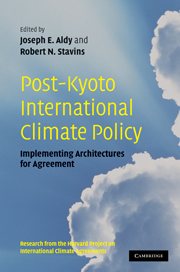Book contents
- Frontmatter
- Contents
- Harvard Environmental Economics Program, International Advisory Board
- Harvard Project on International Climate Agreements, Faculty Steering Committee
- Harvard Project on International Climate Agreements, Project Management
- List of figures
- List of tables
- List of contributors
- Foreword
- 1 Introduction
- Part I Alternative international policy architectures
- Part II Negotiation, assessment, and compliance
- Part III The role and means of technology transfer
- 13 International climate technology strategies
- 14 Mitigation through resource transfers to developing countries: expanding greenhouse gas offsets
- 15 Possible development of a technology clean development mechanism in a post-2012 regime
- Part IV Global climate policy and international trade
- Part V Economic development, adaptation, and deforestation
- Part VI Modeling impacts of alternative allocations of responsibility
- Part VII Synthesis and conclusion
- Appendix A Selected List of Individuals Consulted, Harvard Project on International Climate Agreements
- Appendix B Workshops and Conferences, Harvard Project on International Climate Agreements
- Glossary and Abbreviations
- Index
15 - Possible development of a technology clean development mechanism in a post-2012 regime
Published online by Cambridge University Press: 05 June 2012
- Frontmatter
- Contents
- Harvard Environmental Economics Program, International Advisory Board
- Harvard Project on International Climate Agreements, Faculty Steering Committee
- Harvard Project on International Climate Agreements, Project Management
- List of figures
- List of tables
- List of contributors
- Foreword
- 1 Introduction
- Part I Alternative international policy architectures
- Part II Negotiation, assessment, and compliance
- Part III The role and means of technology transfer
- 13 International climate technology strategies
- 14 Mitigation through resource transfers to developing countries: expanding greenhouse gas offsets
- 15 Possible development of a technology clean development mechanism in a post-2012 regime
- Part IV Global climate policy and international trade
- Part V Economic development, adaptation, and deforestation
- Part VI Modeling impacts of alternative allocations of responsibility
- Part VII Synthesis and conclusion
- Appendix A Selected List of Individuals Consulted, Harvard Project on International Climate Agreements
- Appendix B Workshops and Conferences, Harvard Project on International Climate Agreements
- Glossary and Abbreviations
- Index
Summary
Introduction
Technology is central to the transition to a low-carbon society and to global efforts to cope with climate change. Many technologies that could mitigate greenhouse gas (GHG) emissions exist, but most have not been widely deployed in developing countries. In many of these countries, economic development is producing unsustainable growth in energy demand. Therefore, the transfer of climate-friendly technologies and additional investment flows from developed to developing countries is vital to solve the global climate problem. The importance of technology transfer has been recognized since the Earth Summit in Rio de Janeiro—indeed it is emphasized in both the United Nations Framework Convention on Climate Change (UNFCCC) and the Kyoto Protocol. Yet investment in technology transfer activities remains weak considering the gravity of the issue. After the 2007 Conference of the Parties in Bali, this issue has become increasingly important in the context of negotiations on a future climate regime, even as significant disagreements persist between developing and developed countries.
Article 12 of the Kyoto Protocol established the Clean Development Mechanism (CDM) to serve a two-fold objective: first, to help Annex I countries meet their emission targets in a cost-effective way and second, to support non-Annex I countries in achieving the goal of sustainable development. Though technology transfer is not required for projects that receive CDM credit, experience shows that this program may contribute significantly to technology transfer. However, it is difficult to induce large-scale technology transfer through the CDM in its present form. The project-specific nature of the CDM leads to high transaction costs and makes it difficult to create economies of scale and pool risks across projects of the same type.
- Type
- Chapter
- Information
- Post-Kyoto International Climate PolicyImplementing Architectures for Agreement, pp. 469 - 490Publisher: Cambridge University PressPrint publication year: 2009
- 5
- Cited by

